Angoumois |
|
|
|
| Übersicht – Contents: | |
Diese Seite ist Teil des Projektes
Angoumois |
|
|
|
| Übersicht – Contents: | |
Flaggen – Flags: |
|
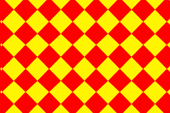 |
Flagge von Angoumois – flag of Angoumois – Drapeau de Angoumois, Quelle/Source, nach/by: Die Welt der Flaggen |
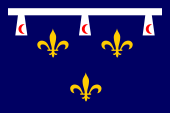 |
1407–1589, Flagge Grafschaft Valois-Angoulême – flag of the County of Valois-Angoulême – Drapeau du Comté de Valois-Angoulême, Quelle/Source, nach/by: svowebmaster.free.fr |
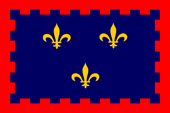 |
18. Jhd./ 18th century, Flagge des Herzogtums Angoulême – flag of the Duchy of Angoulême – Drapeau du Duché d'Angoulême, Quelle/Source, nach/by: ordresaintlouis.blogspot.com |
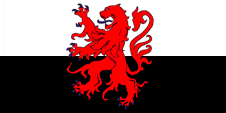 |
1960–2016, inoffizielle Flagge der Region Poitou-Charentes – unofficial flag of the Region of Poitou-Charentes – Drapeau de officieux de la Region Poitou-Charentes, Dank an: Thierry Gilabert, Quelle/Source, nach/by: http://svowebmaster.free.fr |
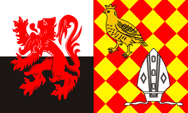 |
1960–2016, inoffizielle Flagge der Region Poitou-Charentes – unofficial flag of the Region of Poitou-Charentes – Drapeau de officieux de la Region Poitou-Charentes Quelle/Source, nach/by: Wikipedia (FR) |
Bedeutung/Ursprung der Flagge – Meaning/Origin of the Flag: |
|
| Die Flagge von Angoumois zeigt das Bild des Wappens, gold-rot schräg geschacht. Es ist das Wappen des Hauses Taillefer, aus dem die zweite Dynastie der Grafen von Angoumois hervorging. Die Taillefers herrschten vom 9. bis zum 13. Jahrhundert. | The flag of Angoumois shows the image of the coat of arms, golden-red lozengy divided. That is the coat of arms of the House of Taillefer, which was the second dynasty of the Counts of Angoulême. The Taillefers ruled from the 9th to the 13th century. |
| Dieses Flagenbild wurde in den modernen Zeiten auf die Gegend übertragen, in der die Grafschaft lag. Flaggen im heutigen Sinne gab es damals noch nicht, eventuell ein Banner mit der Heraldik des Landesherrn. Solche Banner (auch die Wappen) hatten bis auf wenige Ausnahmen nichts mit dem Land zu tun, sondern bezogen sich nur auf die Wappen der jeweiligen Herrscher. | This image of the flag was transfered to the area in which the county was located in modern times. Flags in today's sense did not exist at that time, possibly a banner with the heraldry of the sovereign. With a few exceptions, such banners (including the coats of arms) had in France nothing to do with the country, they were only referred to the coats of arms of the respective rulers. |
| Die zwischen 1960 und 2016 bestehende Region "Poitou-Charentes", zu der die Saintonge gehörte, verwendete eine inoffizielle Flagge. Diese zeigt zwei horizontale Streifen in Weiß und Schwarz und einen roten Löwen in der Mitte. Die Flagge ist neueren Ursprungs und erinnert an das alte Wappen von Poitou aus der Zeit der Plantagenets (siehe Poitou). Ein anderes Modell vereinigt die Heraldik der vier ehemaligen Provinzen, aus denen Poitou-Charentes besteht, Poitou (weiß-schwarz mit rotem Löwen), Angoumois (gold-rot schräg geschacht), Aunis (Rebhuhn) und Saintonge (Mitra). | The
between 1960 and 2016 existing Region of "Poitou-Charentes", to which
Saintonge belonged, used an unofficial flag. It shows
two horizontal stripes in silver and black and a red lion in the middle. The
flag is of recent origin, and it is reminiscent of the old coat of arms of
Poitou from the time of the Plantagenets (look Poitou). Another model combines the heraldry of the four former provinces, in which Poitou-Charentes consists, Poitou (white-black with red lion), Angoumois (golden-red oblique chessboarded), Aunis (partridge) and Saintonge (Mitra). |
| Quelle/Source: Wikipedia (FR), Volker Preuß | |
| Wappen – Coat of arms: | |
 |
866–1220, Taillefer Wappen von Angoumois – Coat of arms of Angoumois – Blason du Angoumois, Quelle/Source, nach/by: Wikipedia (FR) |
 |
1220–1308, Lusignan Wappen der Herren von Lusignan – Coat of arms of the Lords of Lusignan – Blason des Seigneurs de Lusignan, Quelle/Source, nach/by: Wikipedia (FR) |
 |
1407–1589, Valois-Angoulême Wappen Valois-Angoulême – Coat of arms Valois-Angoulême – Blason Valois-Angoulême, Quelle/Source, nach/by: svowebmaster.free.fr |
 |
1619–1650, de Valois Wappen von Charles de Valois – Coat of arms of Charles de Valois – Blason du Charles de Valois, Quelle/Source, nach/by: Wikipedia (FR) |
 |
1675–1696, d'Orléans Wappen von Elisabeth d'Orléans – Coat of arms of Elisabeth d'Orléans – Blason de Elisabeth d'Orléans Quelle/Source, nach/by: Wikipedia (FR) |
 |
seit/since 1757, Angoulême Wappen der Herzöge von Angoulême – Coat of arms of the Dukes of Angoulême – Blason des Ducs d'Angoulême, Quelle/Source, nach/by: ordresaintlouis.blogspot.com |
Bedeutung/Ursprung des Wappens – Meaning/Origin of the Coat of Arms: |
|
| Das Wappen von Angoumois zeigt einen gold-rot schräg geschachten Schild. Es ist das Wappen des Hauses Taillefer, aus dem die zweite Dynastie der Grafen von Angoumois hervorging. Die Taillefers herrschten vom 9. bis zum 13. Jahrhundert. | The coat of arms of the Angoumois shows a golden-red lozengy divided shield. That is the coat of arms of the House of Taillefer, which was the second dynasty of the Counts of Angoulême. The Taillefers ruled from the 9th to the 13th century. |
| Diese Heraldik setzte sich jedoch nicht als heraldisches Merkmal durch, das von den Nachfolgern in der Herrschaft über die Grafschaft in ihre Wappen übernommen worden wäre. | However, this Heraldry did not achieve as a Heraldic feature that would have been taken over in the coats of arms of the successors in the rule over the county. |
| Die Heraldik der Grafschaft Angoumois war recht wechselhaft und mit der Heraldik ihrer jeweiligen Lehnsherren verbunden. | In the Afteryears the heraldry of the County of Angoumois was quite variable and was associated with the heraldry of their lords. |
| Um 1747 scheint eine eine Heraldik für Angoumois (Angoulême) geschaffen worden zu sein, denn mit Charles Philippe de France (1757–1836) aus dem Hause Bourbon (als König von Frankreich Karl X.), erschien ein Wappen, dass mit dem Herzogtum Angoulême in Verbindung zu bringen ist, denn, sein Sohn und Nachfolger als Herzog, Louis Antoine d'Artois (1775–1844) verwendete dieses Wappen auch. | About 1747 it seems that it was created a Heraldry for Angoumois (Angoulême), because with Charles Philippe de France (1757–1836) from the House of Bourbon (as king of France Charles X.), appeared a coat of arms that could be brought into connection to the Duchy of Angoulême, because his son and successor as Duke, Louis Antoine d'Artois (1775–1844) used this coat of arms too. |
| Die damit verbundene Heraldik zeigte den blauen, mit goldenen Lilien belegten Schild der Kapetinger, der von einem roten Rand mit Zinnenschnitt umgeben war. | The associated Heraldry showed the blue, with golden lilies topped shield of the Capetians, which was surrounded by a red border with a merlon-cut. |
| Das Wappen der Kapetinger zeigte drei goldene Lilien auf Blau, jedoch war das Wappen ursprünglich mit Lilien bestreut. Ab 1365 (andere Quellen nennen 1376), wurde die Anzahl der Lilien jedoch auf drei reduziert. Das Lilien-Symbol ist sehr alt, schon der germanische Stamm der Franken hat es verwendet. | The coat
of arms of the Capetians showed three golden lilies on blue, but originally
was the coat of arms sprinkled with lilies. From 1365 (by others sources 1376), the number of lilies was reduced to three. The lily-symbol is very old, already the Germanic tribe of the Franks has used it. |
| Das Haus der Kapetinger stellte die Könige von Frankreich zwischen 987 und 1328. Es geht zurück auf Hugo Capet, Sohn von Hugo dem Großen, der nach dem Tod von Ludwig V. aus dem Hause der Karolinger im Jahre 987 zum König von Frankreich gewählt wurde. Die Kapetinger brachten drei Nebenlinien hervor, die Könige von Frankreich wurden: Valois 1328–1589, Bourbon 1589–1792 und 1814–1830, und Orléans 1830–1848. | The House of the Capetians has provided the kings of France between 987 and 1328. It goes back to Hugo Capet, son of Hugo the Great, who was electet to the King of France, in 987, after the death of King Ludwig V. from the House of the Carolingians. The Capetians brought out three branch lines which became the Kings of France: Valois 1328–1589, Bourbon 1589–1792 and 1814–1830, and Orléans 1830–1848. |
| Dennoch hat sich das Wappen der Taillefers bis in die Neuzeit als Wappen von Angoumois erhalten. | Nevertheless, the coat of arms of Taillefer has survived to modern times as an emblem of Angoumois. |
| Quelle/Source: Heraldique Europeenne, Volker Preuß, Wikipedia (FR), Wikipedia (D) | |
| Die Regionen: Die historischen, französischen Regionen – The historical, french Regions: |
|
|
in Schwarz: Provinz und Gouvernement im Jahre 1776, in Rot: ehemalige
Grafschaft, Provinz oder Gouvernement – in black: governorate and province in 1776, in red: former county, province oder governorate |
| Landkarte/Map: Volker Preuß |
| Erläuterungen zu den Regionen | Explanation about the Regions |
| Die bis zur Französischen Revolution bestehenden Provinzen (bzw. Gouvernements) waren historisch gewachsene Gebilde, die sich oft aus ehemaligen Lehensgebieten der französischen Krone, historischen Grafschaften und Herzogtümern heraus entwickelt hatten, oft über hunderte von Jahren bestanden und Regionalität (kulturelle Besonderheiten und regionale Sprachen) bewahrt hatten. Der Französischen Revolution waren solche Erscheinungen natürlich nicht erwünscht, und im Rahmen ihrer blutigen und gewalttätigen Gleichmacherei wurden jegliche regionale Bezüge ausgemerzt. Kurz nach der Revolution wurden die Provinzen aufgelöst und Frankreich in viele kleine Départements aufgeteilt, die annähernd gleich groß und den gleichen Status haben sollten. Benannt wurden die Départements nach Flüssen oder Gebirgen, um auf keinen Fall den Namen einer der alten Provinz zu verwenden. Es gelang jedoch nicht, die Verbindungen der Einwohner Frankreichs zu ihrer jeweiligen Region abzuschneiden, so dass im Jahre 1960 wieder administrative Regionen geschaffen wurden, um bestimmte Verwaltungsprozesse regional steuern zu können. Dazu wurden Départements, die in einer bestimmten historischen Provinz lagen, zu einer historisch oft gleichnamigen Region administrativ zusammengefasst. Die dabei entstandenen Gebilde decken sich nur annähernd mit den Grenzen der historischen Provinzen. Im streng zentralistischen Frankreich wird jedwede Regionalität vermieden, so dass auch die offiziellen Flaggen dieser Regionen meist aussehen wie Flaggen von Firmen, lieblos, unhistorisch, technokratisch und modernistisch, die hier nicht Gegenstand lexikalischer Betrachtungen sein sollen. Nur in wenigen dieser Regionen gibt es offizielle Flaggen die an historische Vorbilder erinnern. Aber, sogar die Existenz dieser heutigen Regionen ist in Frage gestellt, denn im Jahr 2014 wurde eine Gebietsreform beschlossen, welche die Anzahl der Regionen ab dem Jahr 2016 durch Fusionen auf fast die Hälfte verringert. Jedoch gibt es für fast alle Regionen inoffizielle Flaggen, die an die alten Provinzen und die alte Heraldik erinnern sollen. | The until
the French Revolution existing provinces (or governorates) have been
historically grown structures, which had their roots oftenly in former
fiefdoms of the French crown, historic counties and duchies. They oftenly
existed for hundreds of years and had preserved regionality (e.g. cultural
particularities and regional languages). On the occasion of the French
Revolution such phenomena were of course not desirable, and as part of their
bloody and violent egalitarianism any regional references were eliminated. Shortly after the French Revolution the provinces were dissolved and France became divided into many départements, which should have approximately the same size and the same status. The départements were named after rivers or mountains, to use never and in no circumstances the name of an old province. However, there was no success in cutting the connections of the people of France to their respective regions, so that administrative regions were re-created in 1960, to have a better control in regional administrative processes. In this way became départements, which were placed in a historical province, administratively grouped to an oftenly historically named region. The resulted structures coincide only approximately with the boundaries of the old provinces. In the strictly centralist France any regionality is avoided, so that even the official flags of these regions mostly look like flags of companies, unloving, unhistorical, technocratic and modernistic, and these flags should not be a subject of any lexical considerations here. Only in a few of that regions, exist official flags which remember the historical models. But, even the existence of these today's regions is douptful, because in 2014 was passed a territorial reform valid from the year 2016, that reduces the number of the existing regions by merging to nearly the half. However, there exist unofficial flags in nearly all of these regions, which should remember the old provinces and the old heraldry. |
|
Wikipedia-Link zu den Regionen Frankreichs:
hier klicken FOTW-Link zu den Regionen Frankreichs: hier klicken |
Wikipedia
Link to the regions of France:
click here FOTW Link to the regions of France: click here |
| Quelle/Source: Flags of the World, Wikipedia (D), Volker Preuß | |
Geschichte: |
|
Antike
· Besiedelung durch keltische Stämme 52 v. Chr. · römische Eroberung, das Gebiet der heutigen Saintonge kommt zur Provinz Celtica, später zur Provinz Aquitania 418 · die Westgoten werden als Föderaten angesiedelt 5. Jahrhundert n. Chr. · Eroberung Galliens durch die Franken (unter König Chlodwig), bis 507 Eroberung Aquitaniens, Ausdehnung des Reiches bis an den Atlantik, die Pyrenäen und die die Alpen ca. 550 · administrative Teilung des Reiches in die Königreiche Austrien (Austrasien), Neustrien, sowie das Herzogtum Aquitanien und das Königreich Burgund 639 · Tod von König Dagobert I., die Macht geht auf die Hausmeier aus Austrien über (Karolinger) 687 · Pippin II. setzt sich als Hausmeier im gesamten Frankenreich durch 8. Jahrhundert · Kämpfe zwischen den Herzögen von Aquitanien und den fränkischen Königen 751 · Pippin der Jüngere (III., Enkel von Pippin II.) beseitigt das merowingische Königtum und lässt sich von den Franken zum König wählen 839 · Turpion, erster Graf von Angoulême (Angoumois) 843 · Teilung des Frankenreiches (Vertrag von Verdun) entsteht das Westfränkische Reich von Karl II. (dem Kahlen), das Mittelfränkische Reich von Lothar (Lotharingen), und das Ostfränkische Reich von Ludwig II., Aquitanien (inkl. Angoumois) kommt zum Reich von Karl dem Kahlen 866 · Vulgrin I., Graf von Périgord und Agen, aus dem Haus Taillefer, wird Graf von Angoumois 870 · durch die Teilung des Frankenreiches (Vertrag von Meersen) entsteht das Westfränkische Königreich, das Ostfränkische Königreich, und das Fränkische Königreich Italien 877 · Ludwig besteigt den westfränkischen Thron, Aquitanien wird als Herzogtum an Rainulf, den Grafen von Poitiers, zum Lehen gegeben 880 · durch die Teilung des Frankenreiches (Verträge von Verdun und Ribbemont) entsteht das Westfränkische Königreich (das spätere Frankreich), das Ostfränkische Reich (das spätere Deutsche Reich), das Königreich Italien, das Königreich Hochburgund (unter dem Welfen Rudolf), das Königreich Niederburgund bleibt bestehen 987 · Tod des kinderlosen westfränkischen Königs Ludwig V. (Haus der Karolinger), sein Erbe und Onkel Karl von Niederlothringen konnte sich nicht durchsetzen, der Adel wählt Hugo Capet (Haus der Kapetinger) zum König, die Kapetinger stellen die Könige von Frankreich bis 1328 1220 · Isabella, Tochter von Aymar Taillefer, heiratet in zweiter Ehe Hugo X. von Lusignan, die Grafschaft Angoumois kommt so an das Haus Lusignan 1308 · Tod von Guido I., letzter Graf von Angoumois aus dem Haus Lusignan, die beiden Schwestern verkaufen die Grafschaft an Philipp IV., König von Frankreich, Angoumois kommt so an die Krondomäne 1325 · Karl IV., König von Frankreich, überträgt die Grafschaft Angoumois auf seinen Cousin Philipp von Évreux (ab 1328 auch König von Navarra) 1328 · Tod von König Karl IV. (der Schöne), Aussterben der direkten Linie Kapetinger, nach salischem Recht (Lex Salica) besteigt Graf Philipp von Valois (als König Philipp VI., Sohn des Prinzen Karl von Valois, Cousin ersten Grades von König Karl IV.) den französischen Thron, der englische König Eduard III. erhebt Ansprüche auf den Thron von Frankreich, da er mütterlicherseits ein Neffe von Karl IV. ist, Anlass für den "Hundertjährigen Krieg" (englisch-französischer Krieg, 1338–1453), das Haus Valois stellt die Könige von Frankreich von 1328 bis 1589 1343 · Tod von Philipp von Évreux 1371 · Der Herzog von Berry bekommt das Angoumois zum Lehen 1394 · Karl VI., König von Frankreich, überträgt die Grafschaft Angoumois als Apanage auf seinen jüngeren Bruder Louis de Valois, Herzog von Orléans 1407 · Jean de Valois, ein angehöriger des Hauses Valois-Orléans wird mit der Grafschaft Angoulême (und der Grafschaft Périgord) belehnt, Abspaltung als Haus Valois-Angoulême 1515 · François de Valois (Valois-Angoulême) wird als Franz I. König von Frankreich, die Grafschaft Angoumois kommt an die Krondomäne, Angoumois wird zum Herzogtum erhoben 1583–1619 · das Herzogtum Angoulême (Angoumois) wird als Paragium an Diane de France vergeben 1619 · Charles de Valois, unehelicher Sohn von König Karl IX. wird zum Herzog von Angoulême erhoben, der Titel wird bis 1654 mehrfach an Mitglieder der Linie vergeben, aber auch an das Haus Lothringen 1696 · das Herzogtum wird wieder Teil der Krondomäne 1775–1824 · Louis Antoine de Bourbon, der älteste Sohn von König Karl X., trägt den Titel Herzog von Angoulême 1776 · die schon im 14. Jahrhundert geschaffenen Gouvernements der Zivilverwaltung des Königreiches Frankreich werden auf eine Anzahl von 39 Stück festgeschrieben und entsprechen so der Anzahl der Provinzen, in den Vorjahren konnten auch mehrere Provinzen in einem Gouvernement zusammengefasst sein 1789 · Französische Revolution, die Gouvernements und Provinzen werden abgeschafft, Angoumois kommt größtenteils zum Département Charente 1960 · Wiedereinführung von Regionen in Frankreich, Bildung der Region Poitou-Charentes (Hauptstadt Poitiers), jedoch nicht innerhalb historischer Grenzen, sondern durch Einbindung der Departements Charente-Maritime, Charente, Deux-Sèvres und Vienne 2016 · die Region Poitou-Charentes geht zusammen mit den Regionen Aquitanien und Limousin in der neuen größeren Region Neu-Aquitanien (Nouvelle-Aquitaine) auf |
History: |
|
antiquity
· settlement by Celtic tribes 52 B.C. · Roman conquest, the area of the today's Poitou comes to the province of Celtica, later to the province of Aquitania 418 A.D. · the Visigoths be settled as federates 5th century A.D. · conquest of Gaul by the Franks (under King Clovis) to 507 conquest of Aquitaine, expansion of the empire to the Atlantic Ocean, the Pyrenees and the Alps ca. 550 · administrative division of the empire into the kingdoms of Austrasia and Neustria, and the Duchy of Aquitaine and the Kingdom of Burgundy 639 · death of King Dagobert I., the power goes over to the Mayors of the Palace (maior domus) of Austrasia (House of the Carolingians) 687 · Pepin II. asserts itself as Mayor of the Palace throughout the Frankish Empire 8th century · fights between the Dukes of Aquitania and the Frankish kings 751 · Pepin the Short (III., grandson of Pepin II.) eliminates the Merovingian monarchy and let hisself elect to the king from the Franks 839 · Turpion, mentioned as first Count of Angoulême (Angoumois) 843 · division of the Frankish Empire (Treaty of Verdun), there arise the West Frankish Kingdom of Charles II. (the Bald), the Middle Frankish Kingdom of Lothar (Lotharingia), and the East Frankish Kingdom of Louis II., Aquitaine (including Angoumois) comes to the Empire of Charles the Bald 866 · Vulgrin I., Count of Perigord and Agen, from the House of Taillefer, is Count of Angoulême 870 · at the division of the Frankish Empire (Treaty of Meersen) arises the West Frankish Kingdom, the East Frankish Kingdom, and the Frankish Kingdom of Italy 877 · Ludwig ascends the West Frankish throne, Aquitaine is given as a fief and a duchy to Rainulf, Count of Poitiers (House of the Ramnulfids) 880 · by the division of the Frankish Empire (Treaties of Verdun and Ribbemont) arises the West Frankish Kingdom (later France), the East Frankish Kingdom (later German Empire), the Kingdom of Italy, the Kingdom of Upper Burgundy (under Rudolf the Welf) and the Kingdom of Lower Burgundy persists 987 · death of the childless West Frankish King Louis V. (House of Carolingians), his heir and uncle Charles of Lower Lorraine could not prevail, the nobility elects Hugh Capet (House of Capet) to the king, the Capetians are the Kings of France to 1328 1220 · Isabella, daughter of Aymar Taillefer, merrys as second wife Hugo X. of Lusignan, the County of Angoumois comes in this way the House of Lusignan 1308 · death of Guido I., the last Count of Angoumois out of the House of Lusignan, the two sisters sell the county to Philip IV., King of France, Angoumois comes in this way to the royal domain 1325 · Charles IV., King of France (and from 1328 King of Navarre) transfers the County of Angoumois to his cousin Philip of Évreux 1328 · death of King Charles IV. (the Fair), extinction of the direct Capetian line, according to Salic Law Count Philip of Valois (Son of Prince Charles of Valois, first cousin of King Charles IV.) came on the French throne (as King Philip VI .), the English king Edward III. lays claim to the throne as a maternal nephew of Charles IV., reason for the "Hundred Years War" (Anglo-French War, 1338–1453), out of the House of Valois came all kings of France from 1328 to 1589 1343 · death of Philip of Évreux 1371 · The Duke of Berry gets the Angoumois as fief 1394 · Charles VI., King of France, hands over the County of Angoumois as appanage to his younger brother Louis de Valois, Duke of Orléans 1407 · Jean de Valois, a member of the House of Valois-Orléans, is enfeoffed with the County of Angoulême (and even the County of Périgord), split off as House of Valois-Angoulême 1515 · François de Valois (Valois-Angoulême) becomes King of France as Francis I., the County of Angoumois comes in this way to the royal domain, Angoumois becomes a duchy 1583–1619 · the Duchy of Angoulême (Angoumois) is awarded as Paragium to Diane de France 1619 · Charles de Valois, illegitimate son of King Charles IX. becomes Duke of Angoulême, the title is awarded to 1654 several times to members of the family-line of Valois, but also to the House of Lorraine 1696 · the Duchy is again a part of the royal domain 1775–1824 · Louis Antoine de Bourbon, the eldest son of King Charles X., gets the title of Duke of Angoulême 1776 · the already in the 14th century created governorates of the civil administration of the kingdom of France become committed to a number of 39, and correspond in this way to the number of provinces, in previous years could any provinces be summarized in one governorate 1789 · French Revolution, the governorates and provinces become abolished, Angoumois comes mostly to the department of Charente-Inférieure (later Charente-Maritime) 1960 · reintroduction of regions in France, formation of the region of Poitou-Charentes (capital Poitiers), but not within the historic boundaries, just by integration of the departments of Charente-Maritime, Charente, Deux-Sèvres and Vienne 2016 · the Poitou-Charentes region merges with the Aquitaine and Limousin regions in the new, larger region of New Aquitaine (Nouvelle-Aquitaine) |
| Quelle/Source: Wikipedia (DE), Taschenatlas Weltgeschichte |
Ursprung des Landesnamens – Origin of the Country's Name: |
|
| Der Name
"Angoumois" geht auf die Stadt "Angoulême" zurück. Beide Namen wurden für die Grafschaft und später auch für das Herzogtum verwendet. |
The name
"Angoumois" goes back to the name of the city "Angoulême". Both names were used for the county and later for the duchy too. |
| Quelle/Source: Volker Preuß | |